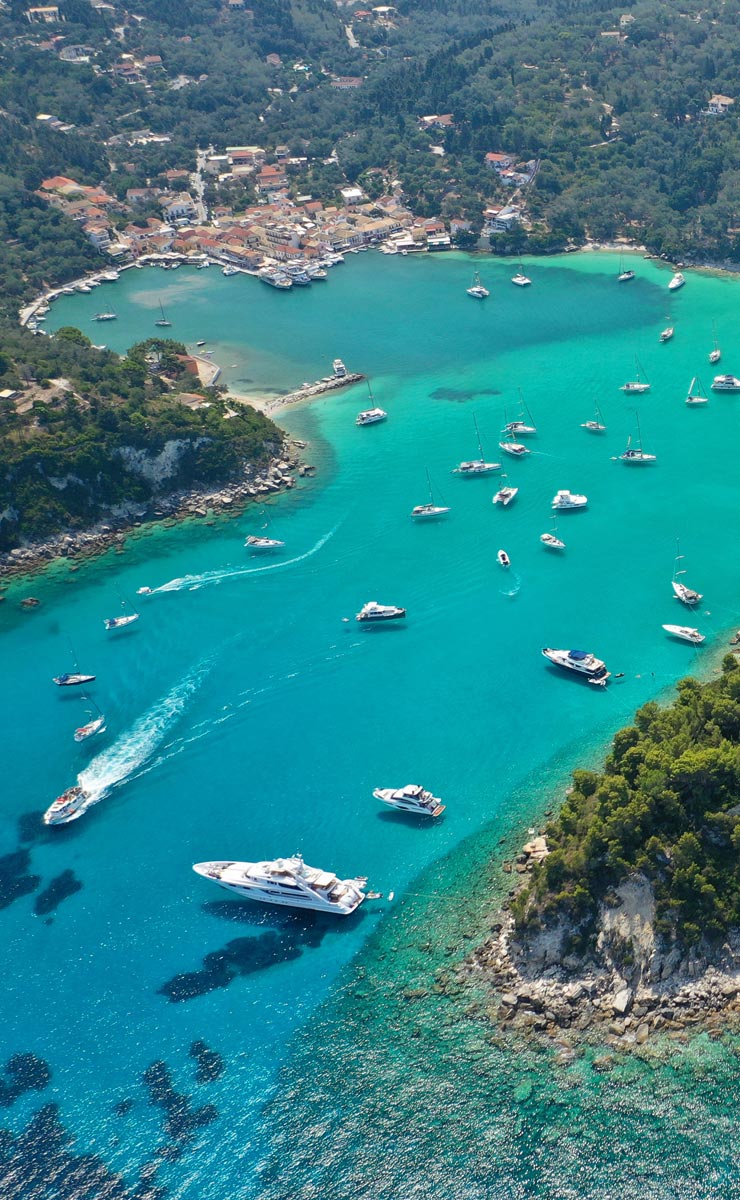Paxi: Small is Beautiful
Paxi (Paxos, Paxoi) is the smallest Ionian island; its dimensions are only 10 km by 4 km. It's 14 km south of Corfu, and opposite Parga on the mainland. "Paxoi" is the more correct, less popular rendering of the island's name. It is really two islands, Paxi, and the even smaller (3 km x 1 km), Antipaxi to the southeast. Paxi produces some on the best wine in Greece, and has abundant, ancient olive orchards. Mythology says that Poseidon wanted a quiet haven for himself and Amphitrite, his wife, so he created Paxi by striking the southern end of Corfu with his trident.
Paxi is situated on a northwest-southeast axis, with higher elevations on its west. There are several chalky cliffs on the west side, with many hidden blue caves accessible by boat only, which leave from the main port town of Gaios. Paxi produces abundant olive oil, but its main economic engine is tourism. Paxi is connected, via the harbor at Gaios, with Corfu and Parga on the mainland via ferry boat and hydrofoil. Sight-seeing boats for the cliffs of the west coast leave from Gaios as well.
History
It's believed that the island was first settled by the Phoenicians, although it was surely inhabited before that. People believe that the island's name comes from the Phoenician word for "trapezoidal," which roughly describes its shape.
After the Hellenistic era, Paxi was taken over by the Romans in the 2nd century BC. In later eras, the Byzantine and past-Byzantine Middle Ages, Paxi was troubled constantly by pirates. As with most of the other Heptanese (Ionian Islands), Paxi had minimal or no direct rule by the Ottoman Turks.
The island changed hands several times, especially in the post-Byzantine world. Its overlords included Crusaders in transit to the Holy Land, and the Venetians, who came at the end of the 14th century. During the Napoleonic era in the early 1800's, the French and Russians took over, and then in 1814, it was Britain's turn to exercise its authority over Paxi and the other 6 Ionian Islands. Then in 1864, along with the rest of the Heptanese, Paxi was reunited with Greece.
Paxi was the European Cultural Village of 2004. The Cultural Village program promotes smaller rural or suburban centers of interest to promote and sustain villages in Europe as a reaction against the urbanization of the continent. Celebration activities included visits by delegates from the other previously chosen 11 villages, art exhibitions, concerts, and a boat parade.
Places of Interest
The east coast is where most of the touristic infrastructure is, supported by a gentle, relatively flat topography. Beaches are for the most part pebbly. There are 3 harbor towns, Gaios, Loggos, and Lakka, characterized by colorful, pink and crème buildings and pristine coves. The inland villages have ancient olive groves with property lines delineated by native, dry-stack stone walls.
Gaios, the largest town, is very much a working fishing village with its boats and caïques moored at the harbor. It features Venetian architecture and narrow side streets. The square is right on the seafront. The town has the usual restaurants, snack bars, and tavernas. The only night club on Paxi can be found here. The atmosphere is quiet, therapeutic, and thoroughly enjoyable. Less than a hundred meters off Gaios is the islet of St. Nicholas, where the Venetians built a fortress. Gaios also has an Art Gallery, and a Folk Museum
The resort village of Lakka, second town of the island, at the northern end of the island, features spectacularly brilliantly aquamarine waters in its large, shallow bay. It is a favorite place for boats to drop anchor and spend the day.
Loggos has a cluster of colorful houses along its small harbor featuring small bars, tavernas, and a restaurant or two.
In the approximate center of the island is the archeological site of Magazia.
Beaches
Mesovrika is on Antipaxi islet, whose waters are similar to the Caribbean. It's secluded, undeveloped, and paradisiacal. It's located on a cove on the island's northeast side. It's a mixed shingle and pebble beach, featuring magnificent views of Paxoi across the way. There's not much sand to be had there, but the two beaches on either side of Mesovrika are sandier. There are a couple tavernas about 5 minutes' walk away.
Voutoumi Beach attracts many locals. It's in a large cove of the northeast side of Paxi. The waters are a stunning turquoise, and shallow enough for young children. You'll need to bring your own umbrella. There is a tavern nearby serving snacks.
Mongosi is a man-made beach about 5 km north of Gaios. Cliffs were dynamited, and the strand was filled with sand. It's a beautiful sandy beach with green waters and cliffs. It has sun beds and umbrellas for rent. There is a nice tavern nearby serving local cuisine.
The crystal clear waters of Anti-Paxos are idyllic and compare with the waters of the Caribbean – a must for swimming and a fantastic day out. Peak season can get very crowded, although people watching during this time can be entertaining!












